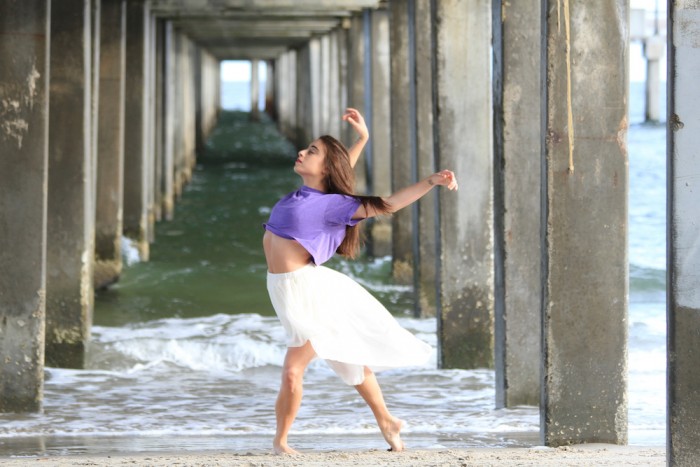“To follow, without halt, one aim: that’s the secret of success.” ~ Anna Pavlova
If there was ever a single quote to summarize the essence of studying classical ballet, that would be it (which makes sense, because Anna Pavlova is among the most important figures in ballet’s history). The dancer must follow, without halt, with one aim: to live the art that he or she has chosen to pursue. Considering how young dancers are when they make that choice, the inevitable struggles they encounter along the way demand that they learn some major life lessons considerably earlier than their non-dancer peers.
As someone who spent nearly two decades dancing (I’m twenty-three), the most recent years being at the preprofessional and professional levels, I know firsthand the blessings and demands of formally studying this exquisite art form: It’s a daunting task marked by a gruelling training regimen, but it’s a life to which no other path could compare. I’ve yet to find any “more valuable” subject matter to deliver such crucial lessons as the ones I’ve learned during my time in the studio, on stage and everywhere else dancing took me.
Of the innumerable pieces of wisdom I’ve picked up over the years, I (somehow) narrowed it down to a few of the most universally enlightening lessons. So, for your personal pondering, here are five things I’ve learned from being a dancer:
1. You are not in control.
Dancers train day in and day out, often for six to eight hours a day, at least six days a week so they can learn to master the body within the context of the art form. The goal is to do this with such finesse that the technique eventually becomes second nature; this way, when dancers take the stage, they never have to think about the mechanics behind their art. The “hard stuff” is already taken care of with the excessive time spent in the studio.
However, dancing is still a live performing art, and in the live performing arts, mistakes happen. The body gets tired, a costume malfunctions, the stage has a lip in the tape, the conductor drinks too much coffee and speeds up the tempos, etc. Anything can happen in performance, including (but not limited to) forgetting choreography, totally wiping out, dropping your partner, missing an entrance or rupturing a tendon.
The point is that no matter how many precautions are taken to ensure a perfect show, the show will not be perfect. Things will go wrong regardless of the preparations to make everything exactly right. For that reason, the dancer trains not only to prevent mistakes (since they’ll happen anyway), but to handle those mistakes as they come with unshakable grace and confidence.
There’s only so much for which we can prepare in this world. Sometimes, the universe doesn’t give us the job offer or life doesn’t go the way we’d planned; sometimes it makes our costume come undone or puts a slick spot on the floor. We couldn’t prevent those things if we tried. We have to accept our lack of control in this regard and simply roll with the punches (or roll on the floor—you know, if/when fall).
2. Not everyone will love or appreciate you, so don’t waste your time striving for that.
The dance world is an eerily smaller and more exacerbated version of the world at large: There is immense beauty to behold, but with that beauty comes a nasty helping of ugly. There are the amazing and talented and kindhearted people and there are the insecure and ruthless and absurdly destructive ones. Translate that to a dancer’s (hopeful) career and we have two kinds of people: Those who want to see us fail and those who support us.
Unfortunately, sometimes the strongest influences in a dancer’s life fall into the former category; bitter teachers or less-than-supportive parents often refuse to invest in their student’s/child’s talent, and so the dancer has no choice but to invest in his or her self. I couldn’t change the fact that my parents weren’t thrilled about my wanting to dance, nor could I change the minds of those teachers who hated me beyond my understanding. Although I fought with all my might to change both situations, I eventually found that all I could do was accept them and move on to find the support I’d need elsewhere.
This only becomes more apparent when auditioning, as I quickly learned that I couldn’t control the judges’ moods that day, the choreographer’s vision, the height and build and overall appearance of the other dancers on the roster or any other factors aside from my own dancing. (Most of the times I didn’t get the job, it had less to do with my dancing and more to do with those other factors.)
I couldn’t change the way the panel saw me. I couldn’t make them love me if I simply wasn’t what they were looking for.
By and large, we can’t make people love us, nor can we change how they see us. Much like life, a dancing career is short and so there’s no time to waste; every moment spent trying to please someone who will simply never appreciate us is a moment taken from a more productive use of time—time spent investing in ourselves so that when those who will appreciate us come along, we’re ready to welcome them into our lives.
3. Pain is an important teacher. Don’t ignore it.
Injuries play an unfortunately large part in a dancer’s world. One wrong move and a career can end before it even begins, which further emphasizes the importance of solid training.
But again, anything can happen.
Whether they’re acute or chronic, injuries hold many if not all of the answers, and often before the dancer thinks to ask any questions. Sure, “flukes” happen, but there’s almost always a “why.” A rolled ankle can be a simple mistake that costs a sprain or a tear, but it can also indicate physical fatigue to the extent that the dancer couldn’t execute the movement properly or react to a misstep quickly enough to prevent injury. With regards to chronic injuries, they tend to reflect a faulty technical habit or an emotional instability that manifests itself in the body; oftentimes, it’s a combination of the two.
Either way, pain always has something to teach the dancer who is willing to learn. It exposes weaknesses and so the corresponding needs to solve them. Ignoring the pain and dancing through it (which is often asked of dancers) merely worsens the problem until dancing (and sometimes functioning in general) becomes nearly impossible.
Pain—be it physical, mental, emotional, spiritual, any form of dis-ease in any area of our lives—is a sign that something isn’t right. Our task is to let it show us the problem so that we can get to get to the source and find a way to heal what’s wrong. We must acknowledge what’s causing the pain before we try to dance again; otherwise, we’ll keep getting hurt in the same ways—until we learn the lessons pain has to teach us.
4. You affect everyone with whom you come into contact.
Dancing in its highest form is the expression of humanity through movement, thus leaving the purveyors of this art form—dancers, directors, teachers, choreographers, etc.—with the huge responsibility of carrying out that task. For an audience, the dancers embody that task most tangibly in that they deliver the culmination of this expression through performance.
Being a dancer in this capacity provides the ultimate perspective on influence; whenever I took the stage, I had the opportunity to interpret my part or role, and with that interpretation came the opportunity to touch an entire audience in some way. I could make them cry, laugh, smile or think. I could make them feel included in my performance or I could keep them at a distance. I could reach them in a way that words would never succeed or I could leave them feeling blank.
While I couldn’t control their interpretation of my interpretation, I could consciously approach my dancing with the audience in mind. I could make artistic choices (to a certain degree) that I felt would most effectively speak to those watching. They did, after all, pay to see me dance.
To make others feel is the ultimate power and curse of the human condition. What we do or say to others has influence in ways we don’t always consider.
Nevertheless, we have the power to make others feel, and we must take it seriously—as though everyone we meet is an audience member, and it’s our responsibility to move them to tears or smiles or laughs or deep reflections.
5. Perseverance doesn’t guarantee success, but it guarantees growth.
I truly have no way of recounting the hours I’ve dedicated to dancing, even in the past four years of training and performing full-time. Sure, I spent however many hours every day physically taking class and rehearsing, but dancers don’t stop being dancers once they leave the studio for the day. Dancers are dancers all the time.
Everything I did with every moment of every day had to do with being a dancer: when I went to sleep, when I woke up, what I put into my body, what I did with my social life, when I went to the gym, when I got a massage, when I got a haircut, when I painted my nails.
Everything.
So, perhaps it makes sense to say I’ve dedicated twenty four hours a day, seven days a week. That wouldn’t be an exaggeration by any means.
I didn’t dedicate myself to dancing because I knew I would become successful someday. I didn’t invest in myself and in my art because it would be a lucrative outcome. I did it because it was all I wanted; it was everything I understood myself to be. I couldn’t exist without it, and I persevered even when I knew I’d never be the best (or good enough, for that matter), even when I felt worthless, even when others tried to stop me from achieving what I knew I could do.
Looking back, I realize that this steadfast perseverance taught me everything I’d need to know about life: It’s not about where we think we’re going, it’s how we choose to get there.
With determination and drive this fierce, I learned my capabilities. I learned my undeniable strength and how far it could take me. I learned that if I could persevere for almost two decades—against the odds, without the promise of achievement—then I could do just about anything.
We learn on the climb, not at the peak. The climb includes rises and falls, progress and setbacks. The peak is just the peak, which is probably nice, but it’s not the climb. It’s not loaded with richness and wisdom and triumphs and epic failures. The peak is not where we grow.
The perseverance of the climb—”without halt, one aim”—guarantees that we will grow whether we reach the peak or not.
These tidbits of wisdom (among a multitude of others) have extended far beyond dancing in my own life, their universal truths withstanding the test of time and circumstance. And after all I’ve learned in my twenty-three years—even including academic education and uncategorizable matters—I’m certain that no better metaphors exist for handling life than the things I’ve learned from being a dancer.
Relephant Favourites:
Once a Dancer.
4 Reasons Why Dancing is the Best Meditation.
The Truth About Living Your Passion.
Author: Sara Rodriguez
Editor: Renée Picard
Photo: Author’s own/taken by KPWee Photography











Read 0 comments and reply